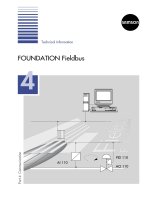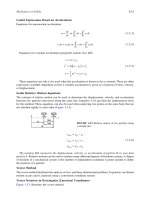ENGINEERING HANDBOOK TECHNICAL INFORMATION potx
Bạn đang xem bản rút gọn của tài liệu. Xem và tải ngay bản đầy đủ của tài liệu tại đây (4.2 MB, 95 trang )
1
ENGINEERING HANDBOOK
STEELMAKING
Basic descriptions of making carbon, alloy, stainless, and tool steel p. 4.
METALS & ALLOYS
Carbon grades, types, and numbering systems; glossary p. 13.
CHEMICAL CONTENT
Identification factors and composition standards p. 27.
HEAT TREATMENT
Quenching, hardening, and other thermal modifications p. 30.
TESTING THE HARDNESS OF METALS
Types and comparisons; glossary p. 34.
MECHANICAL PROPERTIES OF METAL
Comparisons of ductility, stresses; glossary p.41.
MANUFACTURING PROCESSES
G.L. Huyett’s distinct capabilities; glossary p. 53.
COATING, PLATING & THE COLORING OF METALS
Finishes p. 81.
CONVERSION CHARTS
Imperial and metric p. 84.
TECHNICAL INFORMATION
785.392.3017
785.392.2845
FA X
This document and the
information
contained herein is not
a design standard,
design guide or
otherwise, but is here
solely for the
convenience of our
customers. For more
design assistance
contact our plant or
consult the Machinery
Handbook, published
by Industrial Press Inc.,
New York.
Box 232, Exit 49 G.L. Huyett Expy Minneapolis, KS 67467
TABLE OF CONTENTS
Introduction 3
Steelmaking 4
Metals and Alloys 13
Designations for Chemical Content 27
Designations for Heat Treatment 30
Testing the Hardness of Metals 34
Mechanical Properties of Metal 41
Manufacturing Processes 53
Manufacturing Glossary 57
Conversion Coating, Plating, and the Coloring of Metals 81
Conversion Charts 84
Links and Related Sites 89
Index 90
Box 232 • Exit 49 G.L. Huyett Expressway • Minneapolis, Kansas 67467
785-392-3017 • Fax 785-392-2845 • • www.huyett.com
This document was created based on research and experience of Huyett staff.
Invaluable technical information, including statistical data contained in the tables, is from the 26th
Edition Machinery Handbook, copyrighted and published in 2000 by Industrial Press, Inc. of New York,
NY.
Steel making information and flowcharts were produced with information from the website of The
American Iron and Steel Institute (AISI) 1140 Connecticut Ave., NW, Suite 705 Washington, D.C. 20036.
Many technical definitions are from “Everything You Always Wanted to Know About Steel. . . A
Glossary of Terms and Concepts,” Summer 1998 Courtesy of Michelle Applebaum, Managing Director.
Copyright 2000, Salomon Smith Barney Inc.
Other glossary definitions are taken from “Cutting Tool Engineering” (ISSN:0011-4189) Copyright by
CTE Publications Inc. 107 W. Van Buren, Ste. 204, Chicago, IL 60605.
Information regarding differences of steel grades and their properties came from the McMaster-Carr
Supply Company website at www.mcmaster.com, copyright 2003 by the McMaster-Carr Supply
Company.
Much basic and helpful information about steel properties and usage came from Metallurgy FAQ v
1.0 Copyright 1999 Drake H. Damerau, All rights reserved, at Survivalist Books.
This document is provided to customers, vendors, and associates of G.L. Huyett for technical information
relating to the manufacture and sale of non-threaded industrial fasteners. As such, this document is
not a design standard, design guide, or otherwise. G.L. Huyett in not engaged in part and product
design, because of the unknown uses of parts made or distributed by the company. Designs must be
produced and tested by our customers for individual and commercial use.
As such, Huyett assumes no liability of any kind, implied or expressed, for the accuracy, scope, and
completion of the information herein.
INTRODUCTION & ACKNOWLEDGMENTS
© G.L. Huyett 2004
4
Steel is the generic term for a large family of iron–carbon alloys, which are malleable, within some
temperature range, immediately after solidification from the molten state. The principal raw
materials used in steelmaking are iron ore, coal, and limestone. These materials are converted in a
blast furnace into a product known as “pig iron,” which contains considerable amounts of carbon
(above 1.5%), manganese, sulfur, phosphorus, and silicon. Pig iron is hard, brittle, and unsuitable
for direct processing into wrought forms. Pig iron was named long ago when molten iron was
poured through a trench in the ground to flow into shallow earthen holes. The arrangement
looked like newborn pigs suckling. The central channel became known as the “sow,” and the
molds were “pigs.”
Steelmaking is the process of refining pig iron as well as iron and steel scrap by removing undesirable
elements from the melt and then adding desirable elements in predetermined amounts. A primary
reaction in most steelmaking is the combination of carbon with oxygen to form a gas. If dissolved
oxygen is not removed from the melt prior to or during pouring, the gaseous products continue to
evolve during solidification. If the steel is strongly deoxidized by the addition of deoxidizing
elements, no gas is evolved, and the steel is called “killed” because it lies quietly in the molds.
Increasing degrees of gas evolution (decreased deoxidation) characterize steels called “semikilled”,
“capped,” or “rimmed.” The degree of deoxidation affects some of the properties of the steel. In
addition to oxygen, liquid steel contains measurable amounts of dissolved hydrogen and nitrogen.
For some critical steel applications, special deoxidation practices as well as vacuum treatments may
be used to reduce and control dissolved gases.
The carbon content of common steel grades ranges from a few hundredths of a percent to about
1 per cent. All steels also contain varying amounts of other elements, principally manganese, which
acts as a deoxidizer and facilitates hot working. Silicon, phosphorus, and sulfur are also always
present, if only in trace amounts. Other elements may be present, either as residuals that are not
intentionally added, but result from the raw materials or steelmaking practice, or as alloying
elements added to effect changes in the properties of the steel. When reviewing a steel chemical
certification, remember that iron is the element that composes the majority of the chemical values
listed. (See Exhibit I attached)
Steels can be cast to shape, or the cast ingot or strand can be reheated and hot worked by rolling,
forging, extrusion, or other processes into a wrought mill shape. Wrought steels are the most
widely used of engineering materials, offering a multitude of forms, finishes, strengths, and usable
temperature ranges. No other material offers comparable versatility for product design.
Following hot working, steel goes through a “pickling” process. Pickling is a chemical process
whereby steel is run through a progressive series of tanks. Chemicals in the tanks remove oxidation
and impurities from the surface of the product. Hydrochloric acid is a common chemical compound
used in pickling.
Finished steel, typical of the grades used in G.L. Huyett’s manufacturing, are cold rolled (or cold
drawn) after being pickled. Cold finishing, as the process is generally referred to, involves running
the hot rolled pickled and oil product through a series of progressive dies or rollers at room
temperature. The effect of such work stretches the steel, which creates a permanent increase in
the hardness, strength, and finish of the product.
Cold finished steel is typically ready to be used for manufacturing finished goods, but in some
cases, additional processes are performed. For G.L. Huyett keystock, bars are bead blasted to
create a “bright steel” that is free of surface imperfections that could cause problems when inserted
in a keyway.
STEELMAKING
© G.L. Huyett 2004
5
Other grades such as Blue tempered (also known as “Blue Clock,”) which is used to manufacture
shims, are heat treated and ground for finer tolerances and hardened finishes.
Steel must be handled carefully after manufacturing so that straightness tolerances are maintained
and surface imperfections are not created. Proper storage from the elements must be used (including
when shipping on a truck) to minimize corrosion. Finally, steel must be handled carefully during
loading and unloading so that bars are not bent, warped, or “pinged” on the sides. Particularly for
keystock, it is important that edges be sharp, straight, and true to ease installation into the keyway.
© G.L. Huyett 2004
6
A
G
E
H
J
I
F
D
B
C
A
G
E
H
J
I
F
D
B
C
Tolerance Describes the accountable manufacturing tolerance.
Specification Authority Describes the organization that created the specification (AISI is the American Iron and Steel Institute).
Grade Specifically refers to chemical content and physical properties.
Melt Source Denotes actual mill where iron was smelted.
Heat Number The special lot or “melt” from which the product was produced.
Chemical Analysis Lists the content values of various elements expressed as a share of one percent (ex. .30 of carbon=.003).
Tensile Strength Also called ultimate strength, measurement at which steel exhibits strain.
Yield Strength Related to tensile, yield is the stress level at which steel exhibits strain.
Mechanical Properties Represents values determined by physically testing the product.
Elongation Elongation is the increase in gage length or “pull” when steel is tensile tested.
Notice that chemi-
cal values do not
total 100%. The
balance of steel
chemistry would
consist of iron and
trace elements.
© G.L. Huyett 2004
7
© G.L. Huyett 2004
8
© G.L. Huyett 2004
9
© G.L. Huyett 2004
10
© G.L. Huyett 2004
11
© G.L. Huyett 2004
12
© G.L. Huyett 2004
13
Several different numbering systems have been developed for metals and alloys by various trade
associations, professional engineering societies, standards organizations, and by private industries
for their own use. The numerical code used to identify the metal or alloy may or may not be related
to a specification, which is a statement of the technical and commercial requirements that the product
must meet. Numbering systems in use include those developed by the American Iron and Steel Institute
(AISI), Society of Automotive Engineers (SAE), American Society for Testing and Materials (ASTM),
American National Standards Institute (ANSI), Steel Founders Society of America, American Society
of Mechanical Engineers (ASME), American Welding Society (AWS), Aluminum Association, Copper
Development Association, U.S. Department of Defense (Military Specifications), and the General
Accounting Office (Federal Specifications).
The Unified Numbering System (UNS) was developed through a joint effort of the ASTM and the SAE
to provide a means of correlating the different numbering systems for metals and alloys that have a
commercial standing. This system avoids the confusion caused when more than one identification
number is used to specify the same material, or when the same number is assigned to two entirely
different materials. It is important to understand that a UNS number is not a specification; it is an
identification number for metals and alloys for which detailed specifications are provided elsewhere.
Each number consists of a letter prefix followed by five digits. In some, the letter is suggestive of the
family of metals identified by the series, such as “A” for aluminum and “C” for copper. Whenever
possible, the numbers in the UNS groups contain numbering sequences taken directly from other
systems to facilitate identification of the material; e.g., the corresponding UNS number for AISI 1020
steel is G10200.
Carbon Steels
Carbon steel is steel that has properties made up mostly of the element carbon, and which relies
upon carbon content for its structure. The most perfect carbon structure in the world is a diamond,
which is 100% carbon.
Carbon is present in all steel and is the principal hardening element, determining
the level of hardness or strength attainable by quenching. It raises tensile strength, hardness, resistance
to wear and abrasion as the carbon content of steel is increased. It lowers ductility, toughness and
machinability.
Cold Drawn carbon steel is typically numbered with the prefix “10” in the AISI numbering system,
followed by two numbers that represent the nominal percentage of carbon in the product (up to
100%). For example, C1018 has 0.18% carbon, while C1045 has 0.45%.
Generally carbon adds hardness to the material which improves wearability. For carbon contents
above 0.30%, the product may be direct hardened (“through hardened”). Carbon steel beneath this
level typically require carburizing when heat treated in which carbon molecules are introduced so
that a hardened “skin” is able to be developed on the surface, or “case”. This is where the concept of
case hardening is found.
Carbon is maximized at under 1.00% of steel because for levels above this percentage material can
become brittle. Generally, the higher the carbon content, the more difficult carbon steel is to machine.
Alloy Steels
Alloy steels are derivatives of carbon steels where elements are added or deleted to yield certain
properties. Typically these properties include machinability, wearability, and strength. An iron-based
mixture is considered to be an alloy steel when manganese is greater than 0.165%, silicon over 0.5%,
copper above 0.6%, or other minimum quantities of alloying elements such as chromium, nickel,
molybdenum, or tungsten are present.
METALS AND ALLOYS
© G.L. Huyett 2004
14
Iron alloys are the most common ferrous alloy. Steel is a solid solution of iron and carbon, the carbon
is dissolved in the iron; iron is the solvent and carbon is the solute.
Steel, like water, can go through phase changes. With water, the phases are solid, liquid, and gas.
With carbon steel the phases are liquid, austenite, and ferrite. If salt is added to water, the temperature
of all the phase changes are altered. This is why salt is a common ice melt compound. Salt will lower
the transition temperature of the liquid to gas, and lowers the temperature of liquid to solid as well.
When carbon is added to iron, the temperatures are altered in the same way. The more carbon that is
added (to a point), the lower the temperature of the phase change will occur. Carbon also creates
new phases that don’t exist in iron by itself. Pearlite is a mixture of cementite (Fe3C) plus ferrite. The
most carbon that can be dissolved in austenite is 0.80%. This is called “eutectic.” Other alloys can be
described as being eutectic alloys. These alloys have the maximum amount of the alloying element
that can be dissolved into the parent material.
The more carbon you add to steel (above 0.20%), the more pearlite you get, up to the 0.80%. Above
0.80% you get carbides. If a steel has less that 0.20% carbon, all you can get is ferrite. If a steel has
0.40% carbon, you get pearlite and ferrite. If a steel has 0.90% carbon, you get pearlite and carbides.
To know the chemistry of a steel by knowing its grade, remember the following rules: plain carbon
steels are 10xx grades. 10 is plain carbon and the next two numbers are the carbon content. All 10
grades also have manganese, phosphorus, and silicon. The last two numbers of ALL grades designate
the carbon content. If a grade is 12L14 or 10B21, the L means it contains lead for machinability and
the B means it has boron for increased hardenability. If you know the chemistry of the alloy, you will
know its hardness, strengths, and if a thermal treatment will work at all.
Common Carbon Steels and Steel Alloys
The following information should be considered only as a guideline. For specific applications, proper
testing is required. The hardness of a metal is determined by its resistance to deformation, indentation,
or scratching. Rockwell hardness is the most common measure of a metal’s hardness. Soft steels are
usually measured using the Rockwell B scale while harder steels and deep case-hardened steels are
usually measured on the Rockwell C scale. In some cases, one object may fall within more than one
scale (see the hardness comparison chart). For example, a typical steel spring has a Rockwell hardness
of 110 on the B scale and 38 on the C scale. Note: Yield strength is the amount of pressure a material
will accept before becoming permanently deformed.
1018 - Heat treating in contact with carbon (carburizing) hardens the surface of this low-carbon steel.
It’s easy to cold form, bend, braze, and weld. Max. attainable Rockwell hardness is B72. Melting point
is 2800° F. Yield strength is 77,000 psi.
1045 - This medium-carbon steel is stronger than 1018 and is more difficult to machine and weld.
Max. attainable Rockwell hardness is B90. Melting point is 2800° F. Yield strength is 77,000 psi
A36 - General purpose carbon steel is suitable for welding and mechanical fastening. Max. attainable
Rockwell hardness is B68. Melting point is 2000° F. Yield strength is 36,000 psi.
12L14 - A low-carbon steel that has excellent machining characteristics and good ductility that makes
it easy to bend, crimp, and rivet. It is very difficult to weld and cannot be case hardened. Max.
attainable Rockwell hardness is B75-B90. Melting point is 2800° F. Yield strength is 60,000-80,000 psi.
1144 - A medium carbon, resulferized steel with free-machining qualities. 1144 steel heat treats better
than 1045 steel. Stress relieving allows it to obtain maximum ductility with minimum warping. Max.
attainable Rockwell hardness is B97. Melting point is 2750° F. Yield strength is 95,000 psi.
© G.L. Huyett 2004
15
4140 Alloy - Also called “chrome-moly” steel. Ideal for forging and heat treating, 4140 alloy is
tough, ductile, and wear resistant. Max. attainable Rockwell hardness is C20-C25. Melting point is
2750° F. Yield strength is 60,000-105,000 psi.
4140 ASTM A193 Grade B7 Alloy - Similar to 4140 alloy, but it’s already quenched, tempered,
and stress relieved. Rockwell hardness is C35 max.
8630 Alloy - This alloy is tough yet ductile. It responds well to heat treating, exhibits superb core
characteristics, and has good weldability and machining properties. Max. attainable Rockwell
hardness is B85-B97. Melting point is 2800° F. Yield strength is 55,000-90,000 psi.
One of the more common alloys is 1144, a carbon steel in which alloying elements enhance machining.
1144
stress-proof, a product of LaSalle Steel, is an example of an alloy with good machining and
hardenability features that possesses high strength and can be through hardened.
Chrome alloy steels, such as 4130, 4140, and 4340 are so named because chromium content is high
(around 1%), and is the primary alloying element. As one can see, chrome alloy steels begin with
“40” prefix and end in two numbers that account for the nominal percentage of carbon. For example,
4140 has 0.40% of carbon and 0.1% chromium.
Nickel alloy steels substitute nickel in place of roughly half of standard chromium contents for
chrome
alloys. For example, whereas 4140 has 0.0% nickel and 0.1% chromium, 8630 has 0.60% nickel and
0.50% chromium. These alloys are normally prefixed with “80” numbers. 8630 compare to 4140 as
follows:
It is difficult to make mechanical comparisons between chrome alloys and nickel alloys as they are
similar but unique to a grade. Generally nickel alloys can be drawn to a more precise finish size and
therefore are more common in end use steels such as keystock.
Bright Steels
Because of the relevance of these grades to the G.L. Huyett product line, we are giving separate
coverage here. Bright steels typically refer to a class of cold finished square and rectangle bars that
are drawn to more exacting tolerances; they possess sharp corners, perpendicular and parallel sides,
and my be bead blasted to make them “bright.” Bright steels are also known as keystock.
Keystock squares and rectangles are more difficult to draw than rounds because of the 90° angled
corners. Bars must be straight and true and the width must be in a perpendicular plane with the
height. The surface finish of keystock must be free of pits and stresses so that installation is smooth
and efficient. Most customers prefer sharp corners for increased keyway contact (and minimal rocking),
but edges must be sufficiently deburred for ease of use.
C Mn Si P S Cr Ni Mo Other
8630 0.25-0.35 0.65-0.85 0.70 0.04 0.04 0.40-0.70 0.40-0.70 0.20-0.30
4140 0.38-0.43 0.75-1.00 0.035 0.04 0.15-0.35 0.8-1.10
The definition of keystock has been elusive because no single standard exists. Most technicians refer to
“barstock” or “key barstock” as cold finished material drawn from market-ready grades to market-
ready tolerances. “Keystock” refers to barstock carefully drawn to ANSI Class 2 fits.
90°
Perpendicular Planes Sharp Corners Straight Bright Finish
90°
© G.L. Huyett 2004
16
ANSI sets forth two types with the following tolerance specifications:
1/2
3/4
1
1-1/2
2-1/2
+0.000
-0.002
+0.000
-0.002
+0.000
-0.003
+0.000
-0.003
+0.000
-0.004
+0.000
-0.006
1-1/4
3
ANSI B17.1-1967(R1998)
Class 1:
Class 2:
“A clearance or metal-to-metal
side fit obtained by using bar
stock keys and keyseat tolerances.”
“A side fit, with possible interference
or clearance, obtained by using
keystock and keyseat tolerances.”
Type of Key
Key Width
Tolerance
OVER TO (incl.)
SQUARE
PARALLEL
SQUARE
1/2
3/4
1
1-1/2
2-1/2
3-1/2
1-1/4
3
3-1/2
+0.001
-0.000
+0.002
-0.000
+0.003
-0.000
Many users of keystock have used the above specifications in their own product designs, which has
led to two problems. First, because ANSI does not specify a grade, there is confusion. Second, most
American mills will not produce to the Class 2 Fit. Tolerance is too low compared to other cold finished
forms, and the draw is overly technical. As a result, there is often a difference between what customers
want and what is available.
G.L. Huyett has pioneered the development of new cold drawing technologies. Working in concert
with steel mills in both the United States and abroad Huyett has put together the most complete line
of keystock steel anywhere in the world.
Stainless Steels
Stainless steel is the term used for grades of steel that contain more than 0.10% chromium, with or
without other alloying elements. Stainless steel resists corrosion, maintains its strength at high
tolerances and is easily maintained. The most common grades are:
TYPE 304 - The most commonly specified austenitic (chromium-nickel stainless class) stainless steel,
accounting for more than half of the stainless steel produced in the world. This grade withstands
ordinary corrosion in architecture, is durable in typical food processing environments, and resists
most chemicals. Type 304 is available in virtually all product forms and finishes.
TYPE 316 - Austenitic (chromium-nickel stainless class) stainless steel containing 0.2%-0.3%
molybdenum (whereas 304 has none). The inclusion of molybdenum gives 316 greater resistance to
various forms of deterioration.
TYPE 409 - Ferritic (plain chromium stainless category) stainless steel suitable for high
temperatures. This grade has the lowest chromium content of all stainless steels and thus is the
least expensive.
TYPE 410 - The most widely used martensitic (plain chromium stainless class with exceptional
strength) stainless steel, featuring the high level of strength conferred by the martensitics. It is a
low-cost, heat-treatable grade suitable for non-severe corrosion applications.
TYPE 430 - The most widely used ferritic (plain chromium stainless category) stainless steel,
offering general-purpose corrosion resistance, often in decorative applications. 430 stainless is a
martensitic stainless with higher levels of carbon (.15%) that allow it to be heat treated. 430 is also
highly magnetic.
© G.L. Huyett 2004
17
Tool Steels
Tool steels serve primarily for making tools used in manufacturing and in the trades for the working
and forming of metals, wood, plastics, and other industrial materials. Tools must withstand high
specific loads, often concentrated at exposed areas, may have to operate at elevated or rapidly
changing temperatures and in continual contact with abrasive types of work materials, and are often
subjected to shocks, or may have to perform under other varieties of adverse conditions. Nevertheless,
when employed under circumstances that are regarded as normal operating conditions, the tool
should not suffer major damage, untimely wear resulting in the dulling of the edges, or be susceptible
to detrimental metallurgical changes.
Tools for less demanding uses, such as ordinary hand tools, including hammers, chisels, files, mining
bits, etc., are often made of standard AISI steels that are not considered as belonging to any of the
tool steel categories. The steel for most types of tools must be used in a heat-treated state, generally
hardened and tempered, to provide the properties needed for the particular application. The
adaptability to heat treatment with a minimum of harmful effects, which dependably results in the
intended beneficial changes in material properties, is still another requirement that tool steels must
satisfy.
To meet such varied requirements, steel types of different chemical composition, often produced by
special metallurgical processes, have been developed. Due to the large number of tool steel types
produced by the steel mills, which generally are made available with proprietary designations, it is
rather difficult for the user to select those types that are most suitable for any specific application,
unless the recommendations of a particular steel producer or producers are obtained.
Substantial clarification has resulted from the development of a classification system that is now
widely accepted throughout the industry, on the part of both the producers and the users of tool
steels. That system is used in the following as a base for providing concise information on tool steel
types, their properties, and methods of tool steel selection.
Prehardened to HRC 30. Good wear resistance, toughness, and machinability.
4142
Medium carbon resulferized steel with excellent free machining capabilities. Max HRC 22.
1144
H-13
Free machining version of H-13 that is prehardened to HRC 42-46.
Air hardening grade that has higher toughness than D-2, and better wear resistance than S-7.
Max HRC 60.
A-8
Very common cold forming steel for bending, brazing, welding, and forming. Must be carburized during
heat treatment.
1018
O-6
Air hardening material that resists thermal fatigue cracking. Better hardenability and wear resistance
than 4140. Max HRC 54.
V44
O-1
Also known as commercial carbon for use in general metal working. Used where simple heat treatment
is desirable. Max HRC 68.
Used in place of O-1 in applications requiring safer heat treatment, less distortion, and greater wear
resistance. Max HRC 63.
A-2
Offers better wear resistance and higher compressive strength than A-2. Good for long duration runs.
Max HRC 63.
D-2
Used in cold work tools needing high shock resistance. Good toughness with ease of heat treat and
machinability. Max HRC 58.
Dimensionally stable during hardening with high hardness response in low temperatures. Heat treatable
up to HRC 65.
Use
Comparative Properties for the Selection of Drill Rod and Ground Flat Stock
Type
Tool and Die
W-1
M-2
High speed steel with good abrasion resistance and good toughness. Resists softening at high tempera-
tures. Max HRC 65
General Purpose
Machining to
finish job.
Shock resistant .
Machine to finish.
Mold dies.
High heat
environments.
Hot work
die steel.
Prehardened for
machine to finish.
Pneumatic tools.
Weldable.
Forging.
Free Machining
S-7
Oil hardening, non-deforming type tool steel with good resistance to wear and abrasion. Especially
suitable for dies and punches in drawing, forming, and shaping operations.
Tool and Die
© G.L. Huyett 2004
18
Grade W1 (Water-Hardening Steel) - This water-quenching steel heat treats evenly and provides
good toughness and maximum wear resistance. High carbon content and fine grain structure make
it ideal for general use, even without heat treating. Max. attainable Rockwell hardness is C57-C60.
Melting point is 2800° F. Yield strength is 55,000-100,000 psi.
Grade O1 (Oil-Hardening Steel) - A non-shrinking, general purpose tool steel with good abrasion
resistance, toughness, and machinability. It is extremely stable with minimal deformation after
hardening and tempering. Max. attainable Rockwell hardness is C57-C62. Melting point is 2800° F.
Yield strength is 50,000-99,000 psi.
Grade M2 (High-Speed Steel) - This steel resists softening when heated, maintaining a sharp
cutting edge. It is easy to heat treat and has minimal loss of carbon (decarburization) after heat
treating. Max. attainable Rockwell hardness is C65. Melting point is 2580° F. Yield strength is
105,000 psi.
Grade A2 (Air-Hardening Steel) - Made of a very fine grain structure, this steel has excellent
abrasion and wear resistance. Ideal for thin parts that are prone to cracking during heat treating.
Supplied in non-resulferized condition. Max. attainable Rockwell hardness is C62-C65. Melting
point is 2620° F. Yield strength is 108,000 psi.
Grade D2 (High-Chrome Air-Hardening Steel) - The high chromium and carbon content in this
steel provides superior wear resistance and toughness. A low sulfur content makes it difficult to
machine. Max. attainable Rockwell hardness is C62-C65. Melting point is 2525° F. Yield strength is
111,000 psi.
Grade S7 (Shock-Resistant Air-Hardening Steel) - Strong and ductile, this steel is known for its
ability to resist failure from shock. It combines high-impact strength with average wear and
abrasion resistance. Max. attainable Rockwell hardness is C59-C61. Melting point is 2640° F. Yield
strength is 105,000 psi.
Grade A6 (Low-Temperature Air-Hardening Steel) - Heat treat this steel at low temperatures
(1525° to 1575° F). It experiences almost no dimensional changes after heat treating. Max.
attainable Rockwell hardness is C61-C62. Melting point is 2600° F. Yield strength is 110,000 psi.
Grade 4142 - This steel exhibits good wear resistance, toughness, machinability, and high
mechanical properties. Prehardened to a Rockwell hardness of C30. Melting point is 2790° F. Yield
strength is 130,000 psi.
Grade P20 - This hardened, general purpose mold steel is suitable for production of machined or
EDM plastic mold and zinc die casting components. Supplied prehardened to a Rockwell hardness
of C32. Melting point is 2790° F. Yield strength is 130,000 psi.
© G.L. Huyett 2004
19
MACHINABILITY
Low High
DIMENSIONAL STABILITY IN HEAT TREATMENT
Low High
TOUGHNESS
Low High
OLYMPIC (D-2)
SELECT B (A-2)
VDC (H13)
BEARCAT (S-7)
DOUBLE SIX (M-2)
BADGER (O1)
CARBON (W1)
Viscount 44 is pre-hardened.
VDC (H13)
VISCOUNT 44 (H13 MODIFIED)
BEARCAT (S-7)
BADGER (O-1)
CARBON (W-1)
SELECT B (A-2)
DOUBLE SIX (M-2)
OLYMPIC (D-2)
WEAR RESISTANCE AT ROOM TEMPERATURE
Low High
DOUBLE SIX (M-2)
OLYMPIC (D-2)
SELECT B (A-2)
BADGER (O-1)
CARBON (W-1)
BEARCAT (S-7)
VISCOUNT 44
VDC (H13)
CARBON (W-1)
BADGER (O-1)
BEARCAT (S-7)
VDC (H13)
SELECT B (A-2)
DOUBLE SIX (M-2)
OLYMPIC (D-2)
VISCOUNT 44
HOT HARDNESS
Low High
DOUBLE SIX (M-2)
VDC (H13)
VISCOUNT 44 (H13)
Hot hardness not applicable to cold work steels such as
Olympic, Select b, Badger, Carbon and Bearcat.
This Chart summarizes metallurgical
properties of the various grades of tool
steel available. The first step is applying
data from the chart is to examine the
specific application for the important
properties involved. For example, an
ejector pin for die-casting requires top
toughness with good wear resistance
and hot hardness the chart indicates
VDC as a logical start. If the VDC part
wears too rapidly, the next move would
be to Bearcat. Another application
might involve a part for a short run cold
forming die setup. Considering die life
and steel cost, carbon would be first
source if wear or size change in heat
treatment becomes a problem, the next
step would be to use Select B but if size
change in heat treat was the only
problem, then Badger should be tried.
Chemical Composition Limits (%) of Steel— Iron makes up the remaining percentage.
Grade Carbon Manganese Silicon Phosphorus Sulfur Chromium Molybdenum Vanadium Other
1018 0.15-0.2% 0.6-0.9% None 0.04% 0.05% None None None None
1045 0.43-0.5% 0.6-0.9% None 0.04% 0.05% None None None None
A36 0.26% 1.0% 0.40% 0.04% 0.05% None None None None
12L14 0.15% 0.85-1.15% None 0.04-0.09% 0.26 35% None None None
0.15-0.35% Lead
1144 0.4 48% 1.35-1.65% None 0.04% 0.24 33% None None None None
4140 0.42% 0.90% 0.15-0.35% 0.035% 0.04% 1.00% 0.20% None None
8620 0.17 23% 0.6-0.9% 0.15-0.35% 0.035% 0.04% 0.35-0.6% 0.15-0.25% None None
W1 0.95-1.05% 0.3-0.4% 0.1-0.25% 0.025% 0.025% 0.15% 0.1% 0.1%
0.15% Tungsten
O1 0.94% 1.0-1.4% 0.3% 0.03% 0.03% 0.5% None 0.3%
0.4-0.6% Tungsten
M2 0.85% 0.3% 0.3% None None 4% 5% 2%
6% Tungsten
A2 0.95-1.05% 1% 0.3% 0.03% 0.03% 4.75-5.5% 0.9-1.4% 0.25% None
D2 1.4-1.6% 0.6% 0.3% 0.03% 0.03% 11-13% 0.75% 0.9% None
S7 0.45-0.55% 0.2-0.8% 0.2-1% 0.03% 0.03% 3-3.5% 1.3-1.8% 0.2-0.3% None
A6 0.7% 2% 0.3% None None 1% 1% None None
4142 0.42% 0.9% None None None 1% 0.2% None None
P20 0.33% 0.75% 0.5% None None 1.7% 0.4% None None
© G.L. Huyett 2004
20
Alloying Elements and the Effect on Steel
Element Effect
Aluminum Deoxidizes and restricts grain growth.
Boron Increases hardenability.
Carbon Increases hardenability and strength.
Chromium Increases corrosion resistance, hardenability and wear resistance.
Lead Increases machinability.
Manganese Increases hardenability and counteracts brittleness from sulfur.
Molybdenum Deepens hardening, raises creep strength and hot-hardness, enhances corrosion
resistance and increases wear resistance.
Nickel Increases strength and toughness.
Phosphorus Increases strength, machinability, and corrosion resistance.
Silicon Deoxidizes, helps electrical and magnetic properties, improves hardness and oxidation
resistance.
Sulfur Increases machinability, but damages hot forming characteristics.
Titanium Forms carbides, reduces hardness in stainless steels.
Tungsten Increases wear resistance and raises hot strength and hot-hardness.
Vanadium Increases hardenability.
Four Digit Alloy Numbering System
Note: Alloying elements are in weight percent, XX denotes carbon content.
10xx Basic plain carbon steels
11xx Plain carbon steel with high sulfur & low phosphorous (Resulferized)
12xx Plain carbon steel with high sulfur & high phosphorous
13xx 1.75 manganese
23xx 3.50 nickel (series deleted in 1959)
25xx 5.00 nickel (series deleted in 1959)
31xx 1.25 nickel & 0.60 Chromium (series deleted in 1964)
33xx 3.50 nickel & 1.50 Chromium (series deleted in 1964)
40xx 0.20 - 0.25 Molybdenum
41xx 0.50 - 0.95 chromium & 0.12 - 0.30 molybdenum
43xx 1.83 nickel, 0.50 - 0.80 chromium & 0.25 molybdenum
44xx 0.53 molybdenum
46xx 0.85 or 1.83 nickel & 0.23 molybdenum
47xx 1.05 nickel, 0.45 chromium & 0.20 - 0.35 molybdenum
48xx 3.50 nickel, & 0.25 molybdenum
50xx 0.40 chromium
51xx 0.80 - 1.00 chromium
5xxxx 1.04 carbon & 1.03 or 1.45 chromium
61xx 0.60 or 0.95 chromium & 0.13 - 0.15 vanadium
86xx 0.55 nickel, 0.50 chromium & 0.20 molybdenum
87xx 0.55 nickel, 0.50 chromium & 0.25 molybdenum
88xx 0.55 nickel, 0.50 chromium & 0.35 molybdenum
92xx 2.00 silicon
© G.L. Huyett 2004
21
Metals and Alloys Glossary
Aging - A change in the properties of certain metals and alloys that occurs at ambient or moderately
elevated temperatures after a hot-working operation or a heat-treatment (quench aging in ferrous
alloys, natural or artificial aging in ferrous and nonferrous alloys) or after a cold-working operation
(strain aging). The change in properties is often, but not always, due to a phase change (precipitation),
but never involves a change in chemical composition of the metal or alloy.
AI
2
0
3
r
- aluminum oxide - Abrasive material for grinding tools, AI
2
0
3
r
also is the base for ceramics and
is used to coat tools.
Alloy - A substance having metallic properties and being composed of two or more chemical elements
of which at least one is a metal.
Alloying element - An element that is added to a metal to change the metal’s properties.
Alpha iron - The body-centered cubic form of pure iron, stable below 910° C.
Aluminizing - Formation of an aluminum or aluminum-alloy coating on a metal by hot dipping, hot
spraying, or diffusion.
Amorphous - Not having a crystal structure; noncrystalline.
Atmospheric corrosion - The gradual degradation or alteration of a material by contact with
substances present in the atmosphere, such as oxygen, carbon dioxide, water vapor, and sulfur and
chlorine compounds.
Austenite - Metallurgical term for a material that forms when carbon steel is heated above 735° C
and the iron-carbide compounds within the steel dissolve. Quenching the carbon steel at this point
replaces the austenite with martensite, which has an angular molecular structure and high hardness.
Bainite - A metastable aggregate of ferrite and cementite resulting from the transformation of
austenite at temperatures below the pearlite range. Its appearance is feathery if formed in the upper
part of the bainite transformation range; acicular, resembling tempered martensite, if formed in the
lower part.
Black oxide - A black finish on a metal produced by immersing it in hot oxidizing salts or salt solutions.
Carbide - Compound of carbon and one or more metallic elements. For cutting tools, tungsten
carbide, or a combination of these in a cobalt or nickel matrix provides hardness, wear resistance, and
heat resistance. Other elements added to carbide include vanadium, niobium, silicon, boron, and
hafnium.
Carbon steel - Steel combined with varying amounts of carbon. Has no specified minimum quantity
for any alloying element (other than the commonly accepted amounts of manganese, silicon, and
copper) and contains only an incidental amount of any element other than carbon, silicon, manganese,
copper, sulfur, and phosphorus.
Cast alloy - Alloy cast from the molten state; most high-speed steel is melted in an electric-arc
furnace and cast into ingots.
© G.L. Huyett 2004
22
Cast iron - A generic term for a large family of cast ferrous alloys in which the carbon content
exceeds the solubility of carbon in austenite at the eutectic temperature. Most cast irons contain at
least 2% carbon, plus silicon and sulfur, and may or may not contain other alloying elements. For the
various forms gray cast iron, white cast iron, malleable cast iron and ductile cast iron the word
“cast” is often left out.
Ceramic - Made from finely powdered aluminum oxide sintered into the desired form. Ceramics
operate at higher speeds than carbides, plus they wear longer, provide smoother finishes, and can
machine harder materials. They are, however, less shock-resistant. Typically used for high-speed
turning.
Cementite - Fe3C also known as Iron Carbide.
Cold working - Deforming metal plastically under conditions of temperature and strain rate that
induce strain hardening. Working below the recrystallization temperature, which is usually, but not
necessarily, above room temperature.
Commercial-grade tool steel - Low-grade tool steel; not controlled for hardenability.
Composites - Materials composed of different elements, with one element normally embedded in
another, held together by a compatible binder.
Continuous casting - A casting technique in which a cast shape is continuously withdrawn through
the bottom of the mold as it solidifies, so that its length is not determined by mold dimensions. Used
chiefly to produce semifinished mill products such as billets, blooms, ingots, slabs, and tubes.
Corrosion - The chemical or electrochemical reaction between a material, usually a metal, and its
environment that produces a deterioration of the material and its properties.
Corrosion fatigue - The process in which a metal fractures prematurely under conditions of
simultaneous corrosion and repeated cyclic loading at lower stress levels or fewer cycles than would
be required in the absence of the corrosive environment.
Corrosion resistance - Ability of an alloy or material to withstand rust and corrosion; properties
fostered by nickel and chromium in alloys such as stainless steel.
Cutting tool materials - Include cast cobalt-base alloys, ceramics, cemented carbides, cubic boron
nitride, diamond, high-speed steels, and carbon steels.
Diamond - Cubic crystalline form of carbon produced under extreme pressures at elevated
temperatures. The hardest natural substance, it has approximately five times the indentation hardness
of carbide. Its extreme hardness, though makes it susceptible to fracturing.
Die casting - 1. A casting made in a die. 2. A casting process wherein molten metal is forced under
high pressure into the cavity of a metal mold.
Diffusion - 1. Spreading of a consistent in a gas, liquid, or solid, tending to make the composition of
all parts uniform. 2. The spontaneous movement of atoms or molecules to new sites within a material.
Ductile cast iron - A cast iron that has been treated while molten with an element such as magnesium
or cerium to induce the formation of free graphite as nodules or spherulites, which imparts a
measurable degree of ductility to the cast metal. Also known as nodular cast iron, spherulitic graphite
cast iron, or SG iron.
© G.L. Huyett 2004
23
Ductility - The ability of a material to be bent, formed, or stretched without rupturing. Measured by
elongation or reduction of area in a tensile test or by other means.
Elastic limit - The maximum stress that a material can sustain without deforming.
Elasticity - The property of a material to deform under stress and recover its original shape and
dimensions after release of stress.
Elongation - In tensile testing, the increase in the gage length, measured after fracture of the specimen
within the gage length, usually expressed as a percentage of the original gage length.
Embrittlement - Reduction in the normal ductility of a metal due to a physical or chemical change.
Examples include blue brittleness, hydrogen embrittlement, and temper brittleness.
Endurance limit - The maximum stress below which a material can presumably endure an infinite
number of stress cycles.
Extrusion - Conversion of an ingot or billet into lengths of uniform cross section by forcing metal to
flow plastically through a die or orifice.
Fatigue - The phenomenon leading to fracture under repeated or fluctuating stresses having a
maximum value less than the tensile strength of the material. Fatigue fractures are progressive,
beginning as minute cracks that grow under the action of the fluctuating stress.
Fatigue life - The number of cycles of stress that can be sustained prior to failure under a stated test
condition.
Fatigue resistance - Ability of a tool or component to be flexed repeatedly without cracking;
important for bandsaw-blade backing.
Fatigue strength - The maximum stress that can be sustained for a specified number of cycles without
failure, the stress being completely reversed within each cycle unless otherwise stated.
Ferrite - A solid solution of one or more elements in body-centered cubic iron. Unless otherwise
designated (for instance, as chromium ferrite), the solute is generally assumed to be carbon. On some
equilibrium diagrams, there are two ferrite regions separated by an austenite area. The lower area is
alpha ferrite; the upper, delta ferrite. If there is no designation, alpha ferrite is assumed.
Fracture stress - 1. The maximum principal true stress at fracture. Usually refers to un-notched
tensile specimens. 2. The (hypothetical) true stress that will cause fracture without further deformation
at any given strain.
Free-machining steels - Carbon and alloy steels that contain lead, sulfur, or other elements that
improve machinability.
Galling - A condition whereby excessive friction between high spots results in localized welding with
subsequent spalling and further roughening of the rubbing surface(s) of one or both of two mating
parts.
Gray cast iron - A cast iron that gives a gray fracture die to the presence of flake graphite. Often
called gray iron.
© G.L. Huyett 2004
24
Hard chromium - Chromium electrodeposited for engineering purposes (such as to increase the
wear resistance of sliding metal surfaces) rather than as a decorative coating. It is usually applied
directly to basis metal and is customarily thicker than a decorative deposit, but not necessarily harder.
Hardenability - The ability of a ferrous alloy to form martensite when quenched from a temperature
above the upper critical temperature. Hardenability is commonly measured as the distance below a
quenched surface at which the metal exhibits a specific hardness (R
c
50, for example) or a specific
percentage of martensite in the microstructure.
Hardness - Resistance of metal to plastic deformation, usually by indentation. However, the term
may also refer to stiffness or temper, or to resistance to scratching, abrasion, or cutting. Indentation
hardness may be measured by various hardness tests, such as Brinell, Rockwell, and Vickers.
Hot working - Deforming a metal plastically at a temperature and strain rate such that the
recrystallization temperature is exceeded and recrystallization takes place simultaneously with the
deformation, thus avoiding any strain hardening.
HSS, high-speed steel - Tool steel alloyed with tungsten and molybdenum. Permits cutting at
higher speeds and feeds than carbon-steel tools because an HSS tool’s cutting edges don’t soften at
temperatures that soften carbon steel.
Induction hardening - A surface-hardening process in which only the surface layer of a suitable
ferrous workpiece is heated by electromagnetic induction to above the upper critical temperature
and immediately quenched.
Inhibitor - A chemical substance or combination of substances that, when present in the environment,
prevents or reduces corrosion without significant reaction with the components of the environment.
Investment casting - 1. Casting metal into a mold produced by surrounding (investing) an expendable
pattern with a refractory slurry that sets at room temperature, after which the wax, plastic, or frozen-
mercury pattern is removed through the use of heat. Also called precision casting or lost-wax process.
2. A part made by the investment-casting process.
Killed steel - Steel treated with a strong deoxidizing agent such as silicon or aluminum to reduce the
oxygen content so that no reaction occurs between carbon and oxygen during solidification.
Knoop hardness - Hardness rating for very thin materials and plated surfaces.
Machinability, machinability rating - Determines acceptability of a tool for the workpiece to be
machined. Indicates workpiece’s hardness, chemical composition and qualities, microstructure,
propensity to workharden, elasticity, and propensity to be worked cold. In general, the harder a
material, the higher its machinability rating. A material’s machinability also is impacted by the type
and age of machine, its power and rigidity, and the cutting tool used.
Malleable cast iron - A cast iron made by prolonged annealing of white cast iron in which
decarburization or graphitization, or both, take place to eliminate some or all of the cementite. The
graphite is in the form of temper carbon.
Martensite - A generic term for microstructures formed by diffusionless phase transformation in
which the parent and product phases have a specific crystallographic relationship. Martensite is
characterized by an acicular pattern in the microstructure in both ferrous and nonferrous alloys. In
alloys where the solute atoms occupy interstitial positions in the martensitic lattice (such as carbon in
iron), the structure is hard and highly strained; but where the solute atoms occupy substitutional
positions (such as nickel in iron), the martensite is soft and ductile. The amount of high-temperature
© G.L. Huyett 2004
25
phase that transforms to martensite on cooling depends to a large extent on the lowest temperature
attained, there being a rather distinct beginning temperature (Ms) and a temperature at which the
transformation is essentially complete (Mf).
Mechanical properties - The properties of a material that reveal its elastic and inelastic behavior
when force is applied, thereby indicating its suitability for mechanical applications; for example,
modulus of elasticity, tensile strength, elongation, hardness, and fatigue limit. Compare with physical
properties.
Microhardness - The hardness of a material as determined by forcing an indenter such as a Vickers
or Knoop indenter into the surface of the material under very light load; usually, the indentations are
so small that they must be measured with a microscope. Capable of determining hardness of different
microconstituents within a structure, or measuring steep hardness gradients such as those encountered
in casehardening.
Microstructure - The structure of a metal as revealed by microscopic examination of the etched
surface of a polished specimen.
Mild steel - Carbon steel with a maximum of about 0.25% carbon.
Oxidation - 1. A reaction in which there is an increase in valence resulting from a loss of electrons.
Contrast with reduction. 2. A corrosion reaction in which the corroded metal forms an oxide; usually
applied to a reaction with a gas containing elemental oxygen, such as air.
Peening - Mechanical working of a metal by hammer blows or shot impingement.
Pearlite - A lamellar aggregate of ferrite and cementite. Softer than most other microstructures.
Formed from austenite during air cooling from austenite.
Physical properties - Properties of a metal or alloy that are relatively insensitive to structure and
can be measured without the application of force; for example, density, electrical conductivity,
coefficient of thermal expansion, magnetic permeability, and lattice parameter. Does not include
chemical reactivity. Compare with mechanical properties.
Pitting - Localized corrosion of a metal surface, confined to a point or small area, that takes the form
of cavities.
PM, powder metallurgy - Processes in which metallic particles are fused under various combinations
of heat and pressure to create solid metals.
Rockwell hardness - Various scales for determining material hardness. Rockwell C, A, and D scales
measure metal hardness. The Rockwell C, or R
C
, scale, and the Brinell hardness (Bhn) scale are used
most often in connection with cutting tools and machining.
Shear strength - The stress required to produce fracture in the plane of cross section, the conditions
of loading being such that the directions of force and of resistance are parallel and opposite although
their path are offset a specified minimum amount. The maximum load divided by the original cross-
sectional area of a section separated by shear.









